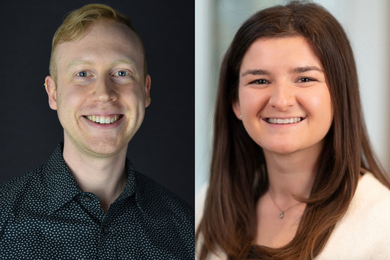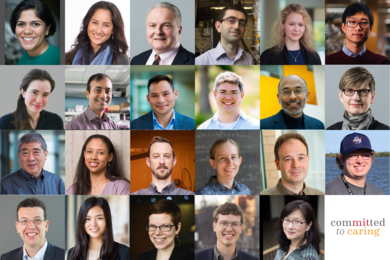Converting an ordinary microscope or surveillance camera into a 3-D imaging system, helping stroke and Parkinson's disease patients rehabilitate faster and stay independent longer, and exploiting a new organic molecule for faster and more powerful computers are among the projects supported by the MIT Deshpande Center for Technological Innovation 's first round of grants.
The center issued its first $1.25 million in Ignition Program and Innovation Program grants last week and announced that proposals for the coming year are due Nov. 4.
The Deshpande Center was established in January as part of the School of Engineering through a $20 million gift from Jaishree Deshpande and Desh Deshpande, the co-founder and chairman of Sycamore Networks. The center plans to award at least $15 million in Ignition Program and Innovation Program grants over the next five years to MIT faculty and students.
The center serves as a catalyst for innovation and entrepreneurship by supporting MIT research and facilitating collaboration among entrepreneurs, venture capitalists, innovative businesses and MIT faculty. The Deshpande Center supports a wide range of emerging technologies, including biotechnology, information technology, new materials, "tiny tech," energy and environmental innovation.
"By issuing its first grants, the Deshpande Center has taken the first step in filling a major gap in the innovation process," said Alex d'Arbeloff, chair of the MIT Corporation and founder of Teradyne. "Prior to the launch of the center, unproven ideas often had difficulty in advancing beyond their theoretical stages, and younger companies lacked ways to hear about new ideas and get involved in bringing them to market."
Added Charles L. Cooney, professor of chemistry and biochemical engineering and faculty director of the center, "Reducing the disconnect between academia and the marketplace is an exciting opportunity that promises to accelerate the rate that technological innovation reaches communities well beyond the boundaries of MIT."
The center awarded five Ignition grants and four Innovation grants, selected from a total of 47 proposals. Ignition grants provide seed funding of up to $50,000 for projects in the early conceptual stages. Innovation Program grants provide up to $250,000 for projects in later stages of development.
Deshpande grant recipients have the opportunity to pursue research and are introduced to entrepreneurial and business resources inside and outside MIT, including venture capitalists, local business resources, the Technology Licensing Office, the MIT Venture Mentoring Service, partnerships with Sloan School of Management courses, the MIT Entrepreneurship Center, the MIT $50K Entrepreneurship Competition, the Industrial Liaison Program and the MIT Enterprise Forum.
The Ignition grants recipients are:
- Mark Baldo, assistant professor of electrical engineering and computer science, for exploiting the properties of a newly developed organic molecule that may lead to faster and more powerful computers.
- Yet-Ming Chiang, professor of materials science and engineering, for ionic colloidal crystals, a novel class of materials that could spawn a whole field of materials research.
- Woodie Flowers, the Pappalardo Professor of Mechanical Engineering, for the Active Joint Brace for Assisted Motion, which could help patients with neuromuscular disorders stay independent longer and rehabilitate faster.
- Sang-Gook Kim, associate professor of mechanical engineering, for a new manufacturing and handling method that may help carbon nanotubes live up to their promise as a new semiconductor technology.
- Scott Manalis, assistant professor at the Media Lab, for new technology for detecting proteins that could lead to a faster, easier way to diagnose disease and develop pharmaceuticals.
The Innovation Program grant recipients are:
- Michael Ernst, assistant professor of electrical engineering and computer science, for automatically generated system spec technology that promises a new way to automatically understand, test and debug highly complex software systems.
- Douglas Hart, associate professor of mechanical engineering, for high-speed 3-D imaging technology to convert any ordinary CCD camera into a 3-D imaging system for applications ranging from endoscopy and identifying terrorists to quality control and home photography.
- Robert Langer, the Germeshausen Professor of Chemical and Biomedical Engineering, for tissue engineering technology for growing new blood vessels. Alexander Slocum, professor of mechanical engineering, for the Nanogate, a new MEMS device with applications ranging from a highly tunable RC filter for cheaper communications devices to a valve for microfluidics for faster drug discovery.
A version of this article appeared in MIT Tech Talk on November 6, 2002.





